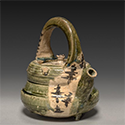|
|
| Show All 10 Results (Text Only) |
|
| Teahouse (Chashitsu) |

|
| Minneapolis Institute of Arts
|
With introductory overview and images of this permanent architectural installation at the MIA that replicates the Sa-an, an 18th-century teahouse in the Gyokurin-in, a temple complex within the famous Zen monastery of Daitoku-ji in Kyoto. The CURATOR INTERVIEW section examines aspects of the room in greater detail. There is also a link to another installation -- an audience hall modeled after a formal 17th-century shoin (study) at the Konchi-in temple in Kyoto -- also with an image gallery and curator interview.
Go to Museum Resource: http://archive.artsmia.org/art-of-asia/architecture/japanese-teahouse.cfm | |
|
|
| The New Way of Tea |
|
| Asia Society
|
Online presentation of a 2002 exhibition about chanoyu, the Japanese way of tea. Includes good background text on the history, principles, and process of the tea ceremony, as well as images of tea rooms and utensils from the exhibition.
Go to Museum Resource: http://sites.asiasociety.org/arts/newwayoftea/index.html | |
|
|
|
| Bamboo Masterworks: Japanese Baskets from the Lloyd Cotsen Collection |
|
| Asia Society
|
Online presentation of an exhibition from 1999, with 25 images and a detailed essay discussing the following topics: 1) Material: Bamboo; 2) Material to Object: Baskets; 3) Bamboo Baskets and the Tea Ceremony; 4) The Basket Makers.
Go to Museum Resource: http://asiasociety.org/arts-culture/asia-society-museum/past-exhibitions/bamboo... | |
|
|
| Bu and Bun: The Arts of War and Peace |
|
| Asian Art Museum of San Francisco
|
In addition to superior strategic and military ability, most elite samurai were expected to be versed in the cultural arts. The warrior’s ideal balance of military and artistic skill is captured well in this description of the sixteenth century daimyo Hosokawa Yusai (1534–1610): “Renowned for his elegant pursuits, he is a complete man combining arts [bun] and arms [bu]. A man of nobility, a descendant of the sixth grandson of the emperor Seiwa, he was a ruler endowed with awesome dignity and inspiring decorum…He built a splendid castle, which was majestic, beautiful and high…He discussed Chinese poetic styles and recited by heart the secret teachings of Japanese poetry…" See also Archery Practice.
Go to Museum Resource: https://education.asianart.org/resources/bu-and-bun-the-arts-of-war-and-peace/ | |
|
|
| Chado: The Japanese Tea Ceremony |
|
| The Cleveland Museum of Art
|
This lesson introduces students to the Japanese tea ceremony to consider the art and the tradition of the tea ceremony and study the serving pieces used in the ceremony by participating in a tea ceremony. Students will learn the importance of the performance of tea ceremony through the history of how it became what it is today.
Go to Museum Resource: http://www.clevelandart.org/lesson-plan-packet/chado-japanese-tea-ceremony | |
|
|
|
| Steeped in History: The Art of Tea [PDF] |
|
| Fowler Museum at UCLA
|
"Throughout its history tea has been a prevalent theme in the visual arts—scenes of tea embellish ceramics and textiles and are the subject of paintings and drawings, and all manner of vessels have been fashioned for the preparation and presentation of tea. Steeped in History brings together rare Chinese ceramics and paintings, 18th- and 19th-century Japanese ceramics and prints, extraordinary English and Colonial American paintings, vintage photographs and historical documents, tea-serving paraphernalia and furniture from many countries, and much more —to tell the fascinating history of tea." This curriculum guide to the exhibition includes five lessons corresponding to the five themes of the exhibition: 1) China, Cradle of Tea Culture; 2) The Way of Tea in Japan; 3) Tea Craze in the West; 4) Tea and Empire; 5) Tea—Parties and Poetry.
Go to Museum Resource: http://www.international.ucla.edu/media/files/Fowler_tea_curriculum.pdf | |
|
|
|
| Show All 10 Results (Text Only) |








